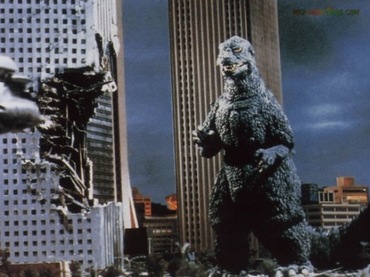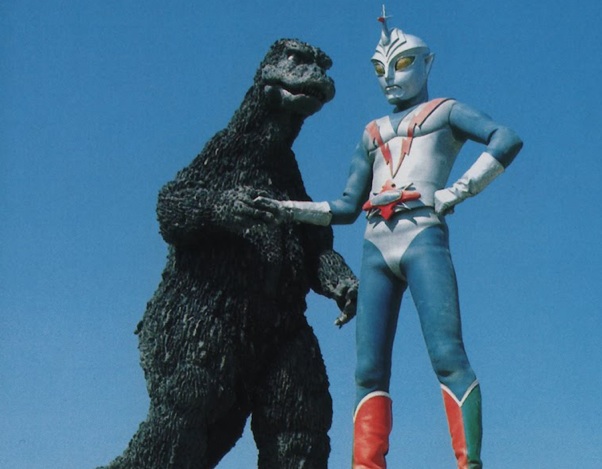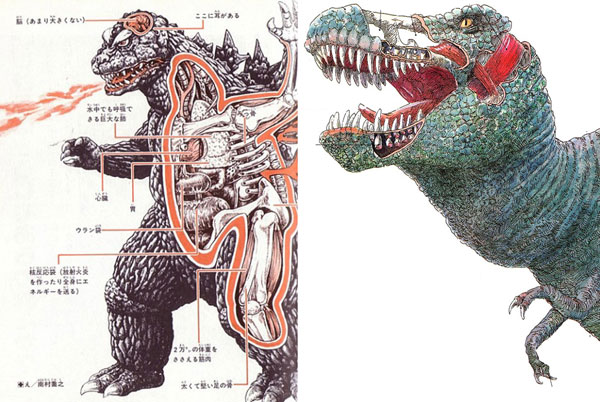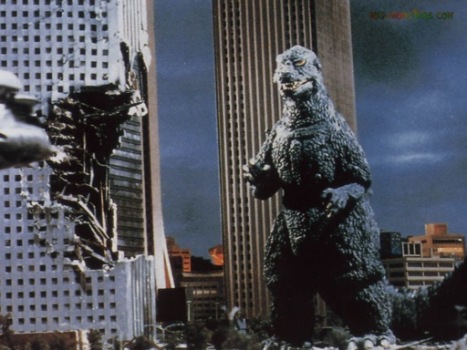9 Misconceptions People Have About Godzilla
 |
Pardon the exhausted clich?, but Godzilla is one of the biggest stars in the world. Counting the 1998 American abomination, he has appeared in 29 films, with a possibly-more-faithful second American take on the way from Legendary Pictures. He’s one of the most recognizable monsters in film history.
And yet, many Americans — not geeks of course, but the general public — may have some mistaken beliefs about the big green guy. Often they’re a result of licensed American products, like dubbed versions of the Japanese films or comics and cartoons, that tried to make Godzilla more “accessible” by turning him into a more traditional fire-breathing dragon.
Well, we here at Topless Robot are nothing if not pedantic about the most minor points regarding our geekish obsessions, so we’re going to set the record straight. Here are nine common misconceptions people have about Godzilla.
9) Godzilla Is a Bad Guy
 |
When most people hear the name Godzilla, they think of a giant monster crushing a city and trampling helpless Japanese. However, they also tend to think of the goofy, campy films of the 1970s.
In the movies of that era, Godzilla was always a good guy, through and through. It started with 1964’s Ghidrah: The Three-Headed Dragon, where Godzilla teamed up with Mothra and Rodan to take down the hydra-like beast. Within a film or two, Godzilla found himself serving as the defender of the earth, fighting an endless stream of sea monsters, alien beasts, and even a robotic version of himself. He even teamed up with an Ultraman rip-off called Zone Fighter in a few episodes of the eponymous television series. It wasn’t until 1984’s Return of Godzilla that he returned to his city-destroying ways.
8) Godzilla Is a Mutated Tyrannosaurus Rex
 |
?
This misconception can be somewhat attributed to the American version of King Kong vs. Godzilla, which included a scene where an elderly scientist posits that Godzilla is a blend of the T. rex and a Stegosaurus.
While Godzilla obviously resembles an early twentieth century conception of a theropod like T. rex, he was never meant to represent that specific dinosaur. Gojira director Ishir? Honda and special effects designer Eiji Tsuburaya cobbled together a distinctive look from several different dinosaurs.
More significantly, 1991’s Godzilla vs. King Ghidorah introduced the idea that Godzilla was actually a new kind of dinosaur (dubbed a “Godzillasaurus”) that was living on an isolated island in the Pacific, like a Japanese version of the Loch Ness Monster. The Godzillasaurus was later mutated by atom bomb testing into the big green guy we know and love.
7) Godzilla Is Invulnerable
Godzilla is only nigh-invulnerable. Oh he’s generally immune to conventional human weapons, thanks to a special gene — “Regenerator G1” — that allows him to heal with Wolverine-like speed.
However, Godzilla has technically died at least four times. In the original Gojira, he is completely disintegrated at the molecular level by Dr. Serizawa’s Oxygen Destroyer. In Godzilla 1985, his heart stops after cadmium missiles are fired down his throat (though he’s revived by the fallout of a nuclear missile strike in the upper atmosphere). In Godzilla vs. Destoroyah, his nuclear heart overloads and he melts down. And in Godzilla, Mothra and King Ghidorah: Giant Monsters All-Out Attack, a naval officer enters Godzilla’s body in a small ship and plants a missile inside the monster’s chest that explodes, causing Godzilla’s atomic energy to go out of control and disintegrate him once again (though his disembodied heart begins to beat again as the credits roll).
6) Godzilla Is a Dumb Brute
It’s true that Godzilla was depicted as a lumbering brute in his earliest films, a walking natural disaster with no rhyme or reason to his behavior. But in 1964’s Ghidrah: The Three-Headed Monster, Godzilla actually has a conversation with Rodan and Mothra; Mothra is trying to convince the other two to fight Ghidorah, and Godzilla initially refuses, saying humans are always trying to hurt him so why should he help them? (He neglects to mention that humans may have a case against him, considering how many of us he’s stepped on.)
After that, Godzilla’s behavior became increasingly anthropomorphic throughout the rest of the Showa era of the 1960s and 1970s. At various times he worked with monstrous allies, developed battle strategies, and appeared to be smitten with a human woman in Godzilla vs. the Sea Monster; he even (regrettably) danced in Godzilla vs. Monster Zero. In Godzilla vs. Gigan (a.k.a. Godzilla on Monster Island), he had a talk with fellow monster Anguirus that was depicted with speech bubbles in the Japanese version and English dubbing in the American version (the above clip features both).
In the later Heisei era of films in the 1990s and on through to the Millennium era, Godzilla is generally portrayed as more animalistic, but definitely cunning. He also develops obvious emotional attachments to his offspring and even appears to have some level of communication with humans at times.
5) Godzilla Beat King Kong in the Japanese Ending to King Kong Vs. Godzilla
At this point, this myth is perhaps more famous for its status as a myth, as most Godzilla fans and anyone with Wikipedia access know it isn’t true; but for years, people thought it was.
While producer John Beck made a lot of changes to King Kong vs. Godzilla when packaging it for American audiences (to the point where it’s practically a different film entirely from the Japanese version), one thing he didn’t have to change was the ending: in both versions, it ends with Godzilla and King Kong falling into the sea, but only Kong coming back to the surface.
The myth that Godzilla emerges victorious in the Japanese version has been traced to a magazine called Spacemen, which made the claim. It was picked up by more notable monster magazines and by the 1980s it had made its way to a Trivial Pursuit question (which claimed the correct answer was that Godzilla had won in the Japanese version). Only in the 1990s with the rise of the Internet was this myth finally dispelled, and now a Godzilla fan is more likely to correct you than repeat the myth.
4) Godzilla Only Attacks Japan
Okay, yeah, Godzilla usually attacks Japan. But he’s made two forays into other stomping grounds. In Destroy All Monsters, Godzilla attacks New York (which is one hell of a swim from the Pacific). And in Godzilla vs. Destoroyah, Godzilla attacks Hong Kong. Oh, and of course he attacked New York again in the 1998 American movie, if you count that, which we don’t.
3) Minilla is Godzilla’s Biological Son
There are few characters so hated in the world of kaiju than Minilla, a.k.a. Minya, a.k.a. the son of Godzilla from the movie of the same name. A blatant attempt to pander to the children who increasingly made up the audience of Godzilla films in the 1960s, Minilla was an atrocious attempt to create a “cute” baby Godzilla. But the attempt went horribly, horribly wrong. This is what you’d get if the Stay Puft Marshmallow Man had so much sex with E.T. that somehow one of them became pregnant.
While your mind starts conceiving that image (you’re welcome), I’ll point out that in his four appearances — Son of Godzilla, Destroy All Monsters, Godzilla’s Revenge, and Godzilla: Final Wars — no one ever explicitly confirms Minilla is Godzilla’s biological offspring. He could be, but given the physical differences it’s by no means a sure bet. Everyone just sort of assumes it because he follows a destructive beast around and blows smoke. I guess that makes Alec Baldwin’s publicist one of Godzilla’s kids, too.
2) Godzilla Is Green
 |
?From the first discovery of dinosaurs in the 1800s, they have often been depicted as being green — after all, they were giant lizards, and most lizards that Europeans and Americans were familiar with were green. This idea was so ingrained in American thought that when U.S. companies began importing Godzilla films as drive-in fare in the 1950s and 1960s, almost every poster depicted the monster as green. When Godzilla got his own (best left forgotten) Hanna-Barbera cartoon in the late ’70s and was colored green, and around the same time had a short-lived Marvel comic in which was — wait for it — green.
But as it turns out, Godzilla was never depicted as being green in any of his early films; in fact, no Japanese film would depict Godzilla as green until 1999. Before that, the Godzilla suit was always charcoal gray. But in 1999’s Godzilla 2000, Godzilla was indeed given green skin, a change carried on through a few of the other Millennium-era sequels.
1) Godzilla Breathes Fire
This one might seem like a matter of semantics, but to the Japanese, who endured an actual nuclear attack during WWII, part of the horror of the original Gojira was that the monster was not only mutated by radiation, but blasted them with radioactive energy. In the first few films it was more of a caustic vapor, but by the mid-1960s it had become a ray, and that’s what it’s been ever since. It’s usually bright blue (with rare exceptions) and prior to the blast, Godzilla’s dorsal plates flicker with the same glow.
Interestingly, in American productions such as the Hanna-Barbera cartoon and the Marvel comic (as well as many marketing posters for the American dubs of the films), Godzilla’s breath was depicted as orange flamethrower-like fire. While some have interpreted this as an attempt to distance Godzilla from his origins as a response to the American bombings of Hiroshima and Nagasaki, it seems more likely the producers simply thought Americans would relate more to a classic green fire-breathing dragon than a charcoal gray creature firing a blue ray.
